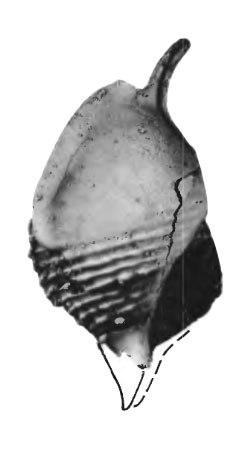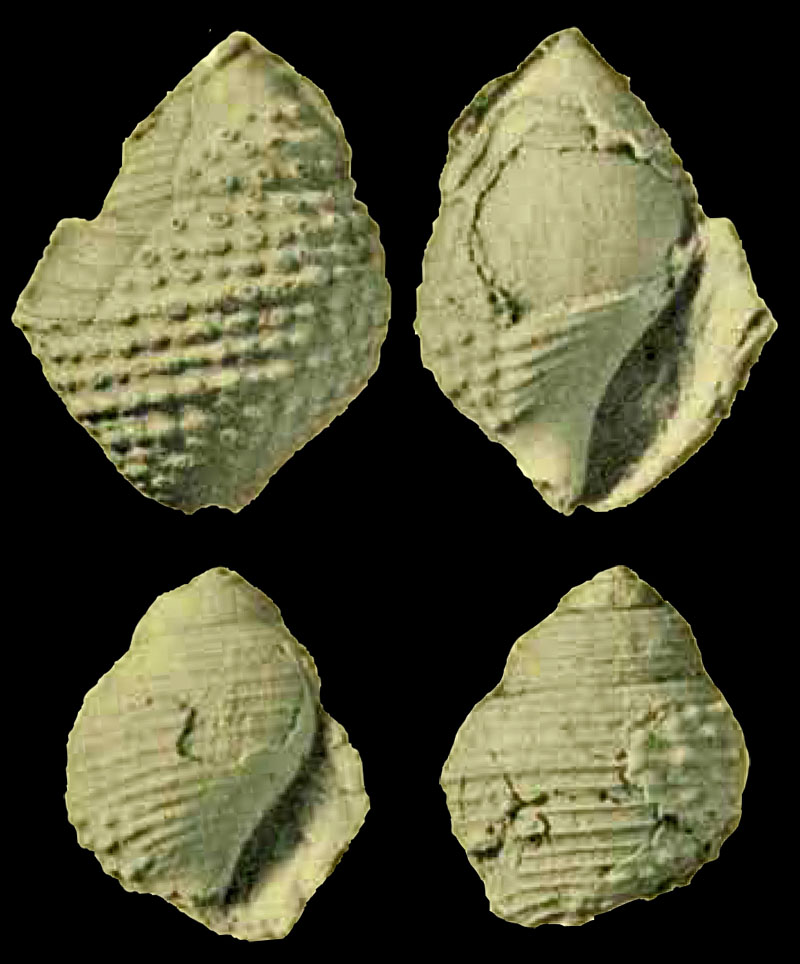|
edit SideBar
|
Species / Tundora Tuberculata
Stromboidea
Original Description of Tundora tuberculata by Stephenson, 1941, p. 313:
- "Shell small, rotund. Spire low; spiral angle 106 degrees at the apex, decreasing rapidly to 55 degrees on the larger whorls below. Protoconch small forming a low, simple, dextral spiral of about 1 1/2 volutions. Whorls 4 or 5, rapidly expanding, broadly rounded on the sides. Suture closely appressed, moderately impressed. Body whorl plump, broadly and regularly rounded from suture to base. The ornamentation on the uncallused body whorl consists of 13 or 14 narrow to sharp spirals separated by proportionately wide, flat-bottomed interspaces; the spirals are strongest on the inflated part of the shell, become weaker below, and nearly fade out on the lower part of the base. The fourth or fifth spiral below the suture is stronger than the others; it increases in strength toward the aperture and may become prominent on an expanded lip, only the beginnings of which are preserved on the three available incomplete specimens. The seventh or eighth spiral below the suture is a little stronger than the nearest adjacent spirals and it also increases in strength toward the aperture; it is slightly bifid on its crest. The whole surface of the adult shell is covered with a proportionately thick callus consisting of 2 or more layers; the spirals are reflected through the callus in accentuated thickness. An unusual feature displayed over much of the callused surface is a series of low, round-topped tubercles, most of which are aligned in rows immediately above the spirals; a few isolated tubercles stand in the interspaces; tubercles are wanting on the parietal wall at the aperture and on the smaller whorls of the spire. On portions of the shells from which the surficial layer of callus has been accidentally broken away the incrementals appear as sharp, closely spaced lines trending upward and obliquely backward somewhat beyond the line of greatest inflation, thence curving around and running obliquely forward and upward to the suture. On one meridian of the spire of the holotype the layer of callus is folded into a narrow, prominent, forward leaning ridge which passes upward over the apex and for at least 2 mm. down over the opposite side. Aperture elongated, of only moderate width, acutely angular at the rear; one paratype bears a remnant of callus showing the imprint of an anal canal extending upward two-thirds of the way across the penultimate whorl. At the anterior end of the aperture is an incomplete, narrow, recurved siphonal canal which is probably not very long in a complete shell. Outer lip partly broken away, but probably thin and more or less expanded. Inner lip forming a thin callus, broadly convex on the parietal wall, excavated low on the base. Columella without folds.
Dimensions of the holotype: Height 12.7+ mm., diameter just back of the beginning of the lip expansion 8.5 mm.
Types: Holotype, U.S.N.M. no. 76984; 1 figured paratype, U.S.N.M. no. 76985; 1 unfigured paratype, U.S.N.M. no. 76986; 1unfigured paratype, U.S.N.M. no. 76987.
Stratum typicum: Neylandville marl, Neylandville Formation, Campanian to Maastrichtian, Upper Cretaceous
Locus typicus: Corsicana road, 2 1/2 miles north of Corbet, Navarro County
Distribution in Texas.ŚNavarro group, Neylandville marl: Corsicana road, 2 1/2 miles north of Corbet, Navarro County (17365, 1 unfigured paratype; Tex. Bu. 17300, holotype and 2 paratypes, 1 figured) .
Tundora tuberculata Stephenson, 1941 pl. 59, fig. 1, 2, 3, 4
History and Synonymy
1964
Sohl, 1964, p. 368:
- "Discussion. The material from the Coffee Sand of Mississippi discussed below represents the second recorded occurrence of this genus. Tundora tuberculata was described by Stephenson (1941, p. 313) from the Neylandville Marl of Navarro County, Tex. This material consists of one specimen lacking the outer lip and anterior tip of the shell, one fragment of a body whorl of another individual, and several parts of expanded outer lips. The specimen figured on plate 54, figure 27, is more complete than Stephenson's holotype and displays well a number of features only suggested by the type lot. The Coffee Sand material consists only of adult shells whose surface is covered by callus, and the fine spiral lirae of the early growth stages noted by Stephenson are not displayed. The mature shell (pl. 54, fig. 27) is rather rotund in outline. Spiral sculpture consisting of nodose spiral cords is well displayed on the anterior slope but is covered over by a smooth coating of callus on the upper part of the body whorl. This callus continues up over the spire obscuring the preceding whorls. The posterior part of the outer lip is drawn out into an elongate siphonal groove that is bounded on the inner side by the callus that covers the spire. On the outer side there is another callus ridge that dies out rapidly on the surface of the preceding whorls. This posterior canal is adnate to the spire but continues above the tip of the shell as a groove incised in a curving spike about 8-9 mm long. From the base of the posterior canal spike another high narrow round-topped ridge of callus begins and trends straight down the side of the spire ending at the periphery of the body whorl. The fragment illustrated on plate 54, figure 20, shows the end of this ridge at the upper right side. This specimen also indicates that the heavy callus cover over the ventral suface of the spire and upper body whorl does not continue onto the dorsal surface but is delimited by the thick Calyptraphorus-like callus ridge and the posterior siphonal canal. The inner lip of the aperture is lightly callused and smooth. During the cleaning of the more complete specimen, the anterior extremity was broken; it has been restored in the illustration (pl. 54, fig. 27). Although the character of the outer lip was not known, Stephenson (1941, p. 313) assumed that it was expanded. One discrete outer lip recovered from the Coffee Sand and figured herein (pl. 54, fig. 21) belongs to this species. There are indications that the individual from which it was broken had tuberculate spiral sculpture. Judging by the shape of the wing, Tundora is more aptly placed in the Aporrhaidae or possibly in the Struthiolaridae [sic] than in the Strombidae where Stephenson placed it. The specimens from the Coffee Sand may well represent a new species. No name is here proposed, because of the incomplete nature of the specimens. Compared to the Texas material, from a higher stratigraphic level, these specimens are larger in size, and the tuberculations on the spirals are less coarse. Due to the state of preservation other comparisons are impracticable.
- Types: Figured specimens USNM 131626.
- Occurrence: Mississippi: Coffee Sand ; Texas: Neylandville Marl.
 Tundora cf. Tundora tuberculatata in Sohl, 1964, pl. 54, fig. 27, Copyright USGS
References
- Sohl N.F. (1964) - Gastropods from the coffee sand (Upper Cretaceous) of Mississippi
- Stephenson, 1941
|


